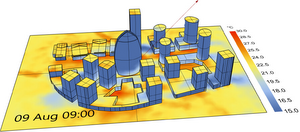Information
- Publication Type: Journal Paper with Conference Talk
- Workgroup(s)/Project(s):
- Date: November 2023
- Journal: Computer Graphics Forum
- Volume: 42
- Open Access: yes
- Number: 7
- Lecturer: Christian Freude
- Article Number: e14957
- ISSN: 1467-8659
- Event: Pacific Graphics 2023
- DOI: 10.1111/cgf.14957
- Pages: 14
- Publisher: WILEY
- Conference date: November 2023
- Keywords: thermal radiation, rendering, computer graphics
Abstract
Architectural design and urban planning are complex design tasks. Predicting the thermal impact of design choices at interactive rates enhances the ability of designers to improve energy efficiency and avoid problematic heat islands while maintaining design quality. We show how to use and adapt methods from computer graphics to efficiently simulate heat transfer via thermal radiation, thereby improving user guidance in the early design phase of large-scale construction projects and helping to increase energy efficiency and outdoor comfort. Our method combines a hardware-accelerated photon tracing approach with a carefully selected finite element discretization, inspired by precomputed radiance transfer. This combination allows us to precompute a radiative transport operator, which we then use to rapidly solve either steady-state or transient heat transport throughout the entire scene. Our formulation integrates time-dependent solar irradiation data without requiring changes in the transport operator, allowing us to quickly analyze many different scenarios such as common weather patterns, monthly or yearly averages, or transient simulations spanning multiple days or weeks. We show how our approach can be used for interactive design workflows such as city planning via fast feedback in the early design phase.Additional Files and Images
Weblinks
BibTeX
@article{freude-2023-prh,
title = "Precomputed radiative heat transport for efficient thermal
simulation",
author = "Christian Freude and David Hahn and Florian Rist and Lukas
Lipp and Michael Wimmer",
year = "2023",
abstract = "Architectural design and urban planning are complex design
tasks. Predicting the thermal impact of design choices at
interactive rates enhances the ability of designers to
improve energy efficiency and avoid problematic heat islands
while maintaining design quality. We show how to use and
adapt methods from computer graphics to efficiently simulate
heat transfer via thermal radiation, thereby improving user
guidance in the early design phase of large-scale
construction projects and helping to increase energy
efficiency and outdoor comfort. Our method combines a
hardware-accelerated photon tracing approach with a
carefully selected finite element discretization, inspired
by precomputed radiance transfer. This combination allows us
to precompute a radiative transport operator, which we then
use to rapidly solve either steady-state or transient heat
transport throughout the entire scene. Our formulation
integrates time-dependent solar irradiation data without
requiring changes in the transport operator, allowing us to
quickly analyze many different scenarios such as common
weather patterns, monthly or yearly averages, or transient
simulations spanning multiple days or weeks. We show how our
approach can be used for interactive design workflows such
as city planning via fast feedback in the early design
phase.",
month = nov,
journal = "Computer Graphics Forum",
volume = "42",
number = "7",
articleno = "e14957",
issn = "1467-8659",
doi = "10.1111/cgf.14957",
pages = "14",
publisher = "WILEY",
keywords = "thermal radiation, rendering, computer graphics",
URL = "https://www.cg.tuwien.ac.at/research/publications/2023/freude-2023-prh/",
}


 paper
paper
